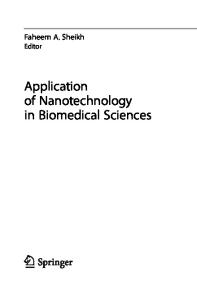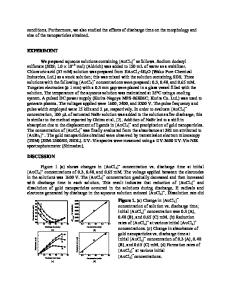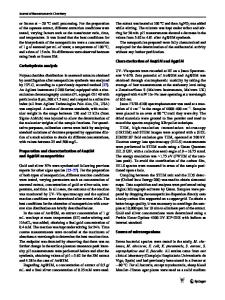Synthesis and Self-assembly of DMPC-conjugated Gold Nanoparticles
- PDF / 731,973 Bytes
- 7 Pages / 612 x 792 pts (letter) Page_size
- 75 Downloads / 398 Views
1061-MM09-08
Synthesis and Self-assembly of DMPC-conjugated Gold Nanoparticles Subhasish Chatterjee1,2, Markrete Krikorian3, Harry D. Gafney1,4, and Bonnie Gersten1,4 1 Chemistry, The Graduate Center of CUNY, New York, NY, 10016 2 Chemistry, The City College of New York, New York, NY, 10031 3 Townsend Harris High School, Flushing, NY, 11367 4 Chemistry, Queens College, Flushing, NY, 11367
ABSTRACT Bio-conjugated nanomaterials play a promising role in the development of novel supramolecular structures, molecular machines, and biosensing devices. In this study, lipidcapped gold nanoparticles were synthesized and allowed to form a self-assembled monolayer structure. The nanoparticles were prepared by a phase transfer method, which involved the reduction of potassium tetrachloroaurate(III) by sodium citrate in an aqueous solution and the simultaneous transfer of the reduced species to an organic medium containing DMPC (1,2dimyristoyl-sn-glycero-3-phosphocholine). The gold nanoparticles were characterized using UV-Vis spectroscopy and dynamic light scattering (DLS) particle-size analysis. In addition, the resulting nanoparticles were examined using transmission electron microscopy (TEM). The Langmuir-Blodgett (LB) technique was used to assemble the DMPC-capped nanoparticles onto a water subphase at room temperature. The measurement of the compression isotherm confirmed the assemblage of lipid capped gold nanoparticles. This method of synthesis of ordered structures utilizing molecular interactions of lipids will be useful in developing novel metamaterials and nanocircuits. INTRODUCTION The assembly of bio-conjugated colloidal nanomaterials has attracted extensive interest due to their tunable physiochemical properties that can be controlled as a function of their size, shape, aggregation state and local environment [1, 2]. Hybrid organic-inorganic nanostructures have versatile technological potential for the development of integrated circuits [2], molecular machines [3], and biosensors [4]. Vigorous attempts have made to obtain assembled structures of metallic [5] and semiconductor [6, 7] nanostructures (nanoparticles, nanorods) [8, 9] using various molecular systems, such as polyelectrolytes [1, 3], surfactants [4], and long-chain hydrocarbons [10]. The ability to precisely control the overall size of an assembled structure and the separation distance between nanoparticulate remains a significant technical challenge [1-4, 11], yet the uniformity in an ordered structure controls the physical properties of the entire architecture [1-3]. Additionally, the stability of nanoparticles in their assembled forms is imperative for the development of an integrated structure [1-4]. The interaction among capping reagents assists to maintain the stability of nanoparticles and the uniformity of their size [11]. Thus, the capping molecules play a crucial role in the formation of a stable assembly of nanoparticles as well as limiting the overall dimension of the assembled architecture [1, 4].
Moreover, it is crucial to retain the na
Data Loading...











